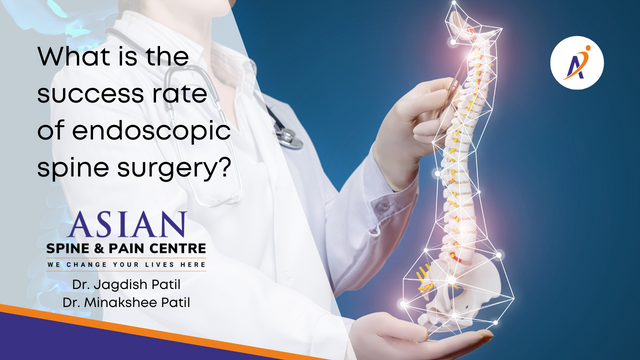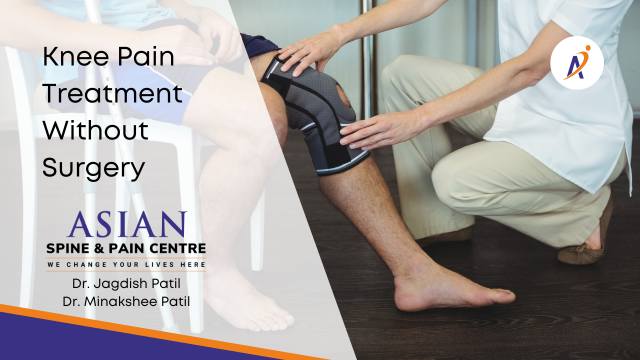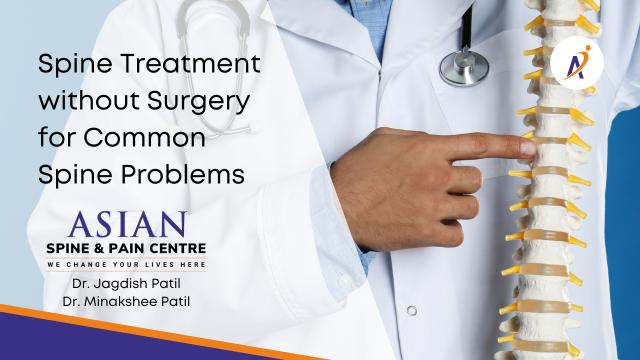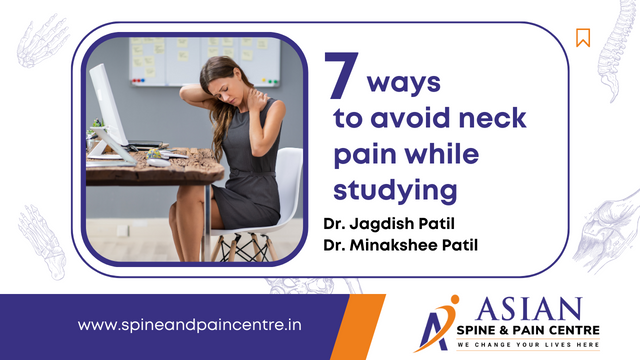Dr. Jagdish Patil & Dr. Minakshee Patil provides spine treatment without Surgery for common spine problems like spinal stenosis, herniated disc, sciatica, arthritis in Pune.
You might be a candidate for endoscopic spine surgery if you have a spinal ailment that has left you with pain, numbness, and other neurological issues. Endoscopic spine surgery is a minimal invasive procedure.
In this blog, you’ll learn everything you need to know about endoscopic spine surgery, including the risks, benefits, success rate and recovery time.
What is endoscopic spine surgery?
Endoscopic spine surgery is most advanced, state-of-the-art form of minimal invasive spine surgery in which micro sized incision (less than one inch) is required. Through which endoscope is inserted to perform surgery. The surgeon can see the anatomy and pathology by projecting the images from the endoscopic camera onto a monitor.
Instruments are inserted after the images are projected, in order to remove any troublesome bone spurs, herniated discs, or thickened ligaments. The surgeon stitches the incision after finishing the procedure.
What are the benefits of endoscopic spine surgery?
- Quicker Recovery
It helps people recuperate quickly. It has little to no tissue trauma in comparison to other conventional techniques that do. As a result, you spend less time in the hospital and can resume your normal activities more quickly.
- Minimally Invasive
There is less tissue injury because the procedure is done through a little incision. The patient experiences reduced pain and scarring as a result.
- Reduced Infection Risk
Because of how small the incision is, there is a lesser chance of infection. Furthermore, it doesn’t involve putting any implants or other foreign things within the body.
What Conditions Does Endoscopic Spine Surgery Treat?
Endoscopic spine surgery can treat various conditions, including herniated discs, degenerative disc disease, and spinal stenosis. It can also decompress the nerves in the spine, which can relieve pain.
How is Endoscopic Spine Surgery Different from Minimally Invasive Spine Surgery?
The size of the incision is a significant variation. A tiny incision is required for Endoscopic spine surgery (ESS), whereas a larger incision is required for minimally invasive spine surgery. This indicates that ESS requires less time to recover than minimally invasive spine surgery.
What is the success rate of endoscopic spine surgery?
Endoscopic spine surgery has a high success rate (more than 90%), with patients often experiencing significant pain relief and better function. Endoscopic spine surgery is generally safe, however there are risk factors involved, as with any operation. Infection, hemorrhage, and nerve injury are among the dangers. With experienced surgeon these risk factors can be avoided.
How long is the recovery and how soon can you return to work after endoscopic spine surgery?
Patients with sedentary work or office jobs can return to regular routine within two weeks from the procedure. Athletes and heavy-duty workers may require longer duration to start work.
Where can you get endoscopic spine surgery in Pune?
At Asian Spine & Pain Centre, Dr. Jagdish Patil, is a orthopedic endoscopic spine surgeon with more than ten years of experience. We provide best-in-class treatments for spine, joints and pain management.
Summary: Endoscopic Spine Surgery is one of the most advanced minimally invasive spine surgery. It has high success rate with least recovery time and side effects. Patients can resume work within couple of weeks after endoscopic spine surgery.
Asian Spine & Pain Centre
We change your lives here!
Asian
Spine And Pain Centre
Asian Spine And Pain Centre
We change your lives here!
Dr. Jagdish Patil
M.B.B.S., M.S.(Orth), FIIPM, FIMISS
Endoscopic Spine & Joint Replacement Surgeon
Pain management Expert
Dr. Minakshee Patil
M.B.B.S., M.D., FPCI, FIPM
Interventional Pain Management Expert
Latest articles
Dr. Jagdish Patil & Dr. Minakshee Patil provides spine treatment without Surgery for common spine problems like spinal stenosis, herniated disc, sciatica, arthritis in Pune.
Follow these 7 simple steps suggested by best pain management expert, Dr. Jagdish Patil, to avoid neck pain while studying long hours.
“World Class Super Speciality Centre for Spine, Joints, Pain & Regenerative Therapies”
Let's Connect
+91-7218113113
Main Clinic
304, 3rd Floor, Choice ‘C’ Apartment, Opp. Millennium Star building, Near Ruby Hall Clinic, Pune 411001.
Send A Mail
Our facilities
Physiotherapy
Procedure Room
Pharmacy
X-ray & Imaging room
Emergency Care
Online Consultancy
FAQs:
Yes, in more than 90% cases with chronic knee pain, a noninvasive or minimal invasive procedures can be used to avoid surgeries. But in 10% cases, surgery is unavoidable and can provide long term benefit. So trust our experts at Asian Spine & pain Centre to provide accurate diagnosis and pain management treatment for your chronic knee pain.
The goal / aim of sports medicine is to maintain, sustain, and at times to regain peak physical fitness i.e., adaptability to stress, physical and mental. Main functions of sports medicine are promotive, educative, formative, recreative, competitive, therapeutic and rehabilitative in nature. At Asian Spine & Pain Centre, we provide complete care of sport sports injuries for athletes in Pune.
Yes, in most cases, physiotherapy is must to regain complete joint mobility and muscular strength. It can be required after any orthopedic treatment either surgical or non-surgical. At Asian Spine & pain Centre, we have a tea, of experienced physiotherapists to provide complete care.
You might have serious back problem or emergency for which you need immediate orthopedic care. Following signs can help you to identify these serious situations – Sharp pain rather than a dull ache, Radiating pain, Sudden weakness in the legs, incontinence, numbness or needle like pain in the groin.
Yes. X-rays are often a good tool for determining if arthritis exists and, specifically, what type. Common types of arthritis include rheumatoid arthritis, psoriatic arthritis, and osteoarthritis. Early in the disease process, more sophisticated imaging may be necessary, especially MRI. We do provide X-ray imaging services at Asian Spine & Pain Centre.
If you’re experiencing chronic pain, a doctor may recommend that you have a nerve block, a temporary or permanent procedure that disrupts specific nerve activity. It can help diagnose or treat certain types of neuropathic pain, or pain caused by nerve dysfunction or damage. At Asian Spine & pain centre, we use nerve block therapy in selected cases of chronic pain.
As is often the case, recovery time can vary from person to person depending on the location of the surgery, the type of surgery required and the lifestyle of the patient. However, most patients are able to leave the hospital the same day and are typically able to return to their active lives within 4-6 weeks after surgery. However, some are back to normal in 1-2 weeks.
You shouldn’t downhill ski or play contact sports such as football and soccer. In general, avoid sports that require jerking, twisting, pulling, or running. You should be able to do lower-impact activities, such as hiking, gardening, swimming, playing tennis, and golfing.
Arthroscopy is a procedure for diagnosing and treating joint problems. A surgeon inserts a narrow tube attached to a fiber-optic video camera through a small incision — about the size of a buttonhole. The view inside your joint is transmitted to a high-definition video monitor. Arthroscopy allows the surgeon to see inside your joint without making a large incision. Surgeons can even repair some types of joint damage during arthroscopy, with pencil-thin surgical instruments inserted through additional small incisions.




